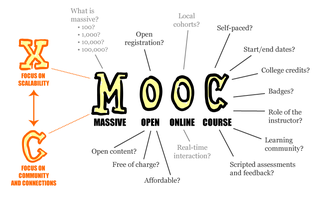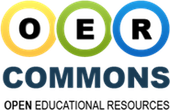
Distance education, also called distance learning, is the education of students who may not always be physically present at a school. Traditionally, this usually involved correspondence courses wherein the student corresponded with the school via mail. Today, it usually involves online education. A distance learning program can be completely distance learning, or a combination of distance learning and traditional classroom instruction. Massive open online courses (MOOCs), offering large-scale interactive participation and open access through the World Wide Web or other network technologies, are recent educational modes in distance education. A number of other terms are used roughly synonymously with distance education.
Openness is an overarching concept or philosophy that is characterized by an emphasis on transparency and collaboration. That is, openness refers to "accessibility of knowledge, technology and other resources; the transparency of action; the permeability of organisational structures; and the inclusiveness of participation". Openness can be said to be the opposite of closedness, central authority and secrecy.

Open educational resources (OER) are freely accessible, openly licensed text, media, and other digital assets that are useful for teaching, learning, and assessing, as well as for research purposes.
OpenCourseWare (OCW) are course lessons created at universities and published for free via the Internet. OCW projects first appeared in the late 1990s, and after gaining traction in Europe and then the United States have become a worldwide means of delivering educational content.

Open education is an educational movement founded on openness, with connections to other educational movements such as critical pedagogy, and with an educational stance which favours widening participation and inclusiveness in society. Open education broadens access to the learning and training traditionally offered through formal education systems and is typically offered through online and distance education. The qualifier "open" refers to the elimination of barriers that can preclude both opportunities and recognition for participation in institution-based learning. One aspect of openness or "opening up" education is the development and adoption of open educational resources in support of open educational practices.
An open textbook is a textbook licensed under an open copyright license, and made available online to be freely used by students, teachers and members of the public. Many open textbooks are distributed in either print, e-book, or audio formats that may be downloaded or purchased at little or no cost.
The Tufts OpenCourseWare (OCW) project, was a web-based publication of educational material from a number of Tufts University courses, providing open sharing of free, searchable, high-quality course content to educators, students, and self-learners throughout the global community. The Tufts OCW initiative encouraged the publication and free exchange of course materials on the World Wide Web. First launched in June 2005, Tufts OCW provided materials with strong representation from Tufts’ health sciences schools, some of which were equivalent to textbooks in depth. All materials on the Tufts OCW site were accessible and free of charge. As Tufts OCW is not a distance learning program, no registration, applications, prerequisites, or fees are required and no credit is granted. Tufts ended funding for its Open Courseware initiative in 2014, and content on the Tufts OCW web site was removed on June 30, 2018.
Open.Michigan is a collection of open initiatives and projects at the University of Michigan (U-M). Open.Michigan supports the open access and use of U-M resources for teaching, learning, and research. Open.Michigan promotes open content licensing and supports the reuse, redistribution, and remixing of educational materials for use by others worldwide. Some of the key efforts underway under the Open.Michigan umbrella include U-M’s Open Educational Resources publishing activities, development of software tools that support creating open content, and various open content repositories.

A massive open online course is an online course aimed at unlimited participation and open access via the Web. In addition to traditional course materials, such as filmed lectures, readings, and problem sets, many MOOCs provide interactive courses with user forums or social media discussions to support community interactions among students, professors, and teaching assistants (TAs), as well as immediate feedback to quick quizzes and assignments. MOOCs are a widely researched development in distance education, first introduced in 2008, that emerged as a popular mode of learning in 2012.

The Institute for the Study of Knowledge Management in Education (ISKME), is a 501(c)(3) non-profit organization founded in 2002. Located in Half Moon Bay, California, its mission is to help schools, colleges, and other educational institutions to gather and use data, share information, and make knowledge openly accessible to students, educators, and the public.
Open educational practices (OEP) are part the broader open education landscape, including the openness movement in general. It is a term with multiple layers and dimensions and is often used interchangeably with open pedagogy or open practices. OEP represent teaching and learning techniques that draw upon open and participatory technologies and high-quality open educational resources (OER) in order to facilitate collaborative and flexible learning. Because OEP emerged from the study of OER, there is a strong connection between the two concepts. OEP, for example, often, but not always, involve the application of OER to the teaching and learning process. Open educational practices aim to take the focus beyond building further access to OER and consider how in practice, such resources support education and promote quality and innovation in teaching and learning. The focus in OEP is on reproduction/understanding, connecting information, application, competence, and responsibility rather than the availability of good resources. OEP is a broad concept which can be characterised by a range of collaborative pedagogical practices that include the use, reuse, and creation of OER and that often employ social and participatory technologies for interaction, peer-learning, knowledge creation and sharing, empowerment of learners, and open sharing of teaching practices.

OER Commons is a freely accessible online library that allows teachers and others to search and discover open educational resources (OER) and other freely available instructional materials.
Open educational resources (OER) are learning materials that reside in the public domain or have been released under an intellectual property license that permits their free use and re-purposing by others. OER policies are adopted by governments, institutions or organisations in support of the creation and use of open content, specifically open educational resources (OER), and related open educational practices.
Open Educational Resource (OER) Universitas is a collaboration of post-secondary educational institutions and other organisations with the aim of providing opportunities to learn from open educational resources and gain credit at costs lower than traditional degrees. The conceptual framework underpinning ENGAGEDe in free learning, and receive formal accreditation from participating universities. It is possible to use OER Universitas partners as an alternative paths to earning a degree
This outline of open educational resources provides a way of navigating concepts and topics in relation to the open educational resources (OER) movement.
The UNESCO 2012 Paris OER Declaration, otherwise known as the Paris declaration on Open Educational Resources, is a declaration urging governments to promote the use of open educational resources (OERs) and calling for publicly funded educational materials to be released in a freely reusable form.
Language MOOCs are web-based online courses freely accessible for a limited period of time, created for those interested in developing their skills in a foreign language. As Sokolik (2014) states, enrolment is large, free and not restricted to students by age or geographic location. They have to follow the format of a course, i.e., include a syllabus and schedule and offer the guidance of one or several instructors. The MOOCs are not so new, since courses with such characteristics had been available online for quite a lot of time before Dave Cormier coined the term 'MOOC' in 2008. Furthermore, MOOCs are generally regarded as the natural evolution of OERs, which are freely accessible materials used in Education for teaching, learning and assessment.
Online credentials for learning are digital credentials that are offered in place of traditional paper credentials for a skill or educational achievement. They are directly linked to the accelerated development of internet communication technologies, the development of digital badges, electronic passports and massive open online courses (MOOCs).
Open educational resources in Canada are the various initiatives related to open education, open educational resources (OER), open pedagogies (OEP), open educational practices (OEP), and open scholarship that are established nationally and provincially across Canadian K-12 and higher education sectors, and where Canadian based inititatives extend to international collaborations.
Educational technology in sub-Saharan Africa refers to the promotion, development and use of information and communication technologies (ICT), m-learning, media, and other technological tools to improve aspects of education in sub-Saharan Africa. Since the 1960s, various information and communication technologies have aroused strong interest in sub-Saharan Africa as a way of increasing access to education, and enhancing its quality and fairness.
![]() This article incorporates text from a free content work. Licensed under CC-BY-SA IGO 3.0 License statement/permission on Wikimedia Commons . Text taken from Open Educational Resources: Policy, Costs and Transformation , 28-37, Bossu, Carina, UNESCO. UNESCO.
This article incorporates text from a free content work. Licensed under CC-BY-SA IGO 3.0 License statement/permission on Wikimedia Commons . Text taken from Open Educational Resources: Policy, Costs and Transformation , 28-37, Bossu, Carina, UNESCO. UNESCO. 




